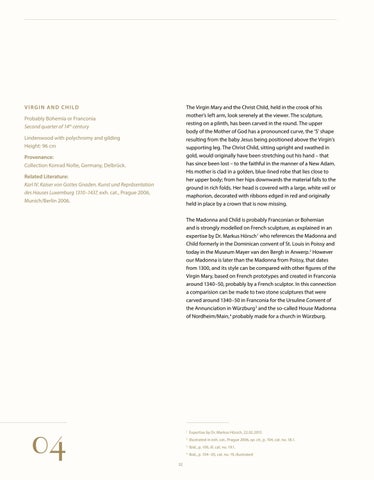VIRGIN AND CHILD
The Virgin Mary and the Christ Child, held in the crook of his mother’s left arm, look serenely at the viewer. The sculpture, resting on a plinth, has been carved in the round. The upper body of the Mother of God has a pronounced curve, the ‘S’ shape resulting from the baby Jesus being positioned above the Virgin’s supporting leg. The Christ Child, sitting upright and swathed in gold, would originally have been stretching out his hand – that has since been lost – to the faithful in the manner of a New Adam. His mother is clad in a golden, blue-lined robe that lies close to her upper body; from her hips downwards the material falls to the ground in rich folds. Her head is covered with a large, white veil or maphorion, decorated with ribbons edged in red and originally held in place by a crown that is now missing.
Probably Bohemia or Franconia Second quarter of 14th century Lindenwood with polychromy and gilding Height: 96 cm Provenance: Collection Konrad Nolte, Germany, Delbrück. Related Literature: Karl IV. Kaiser von Gottes Gnaden. Kunst und Repräsentation des Hauses Luxemburg 1310 –1437, exh. cat., Prague 2006, Munich/Berlin 2006.
The Madonna and Child is probably Franconian or Bohemian and is strongly modelled on French sculpture, as explained in an expertise by Dr. Markus Hörsch 1 who references the Madonna and Child formerly in the Dominican convent of St. Louis in Poissy and today in the Museum Mayer van den Bergh in Anwerp.2 However our Madonna is later than the Madonna from Poissy, that dates from 1300, and its style can be compared with other figures of the Virgin Mary, based on French prototypes and created in Franconia around 1340–50, probably by a French sculptor. In this connection a comparision can be made to two stone sculptures that were carved around 1340–50 in Franconia for the Ursuline Convent of the Annunciation in Würzburg 3 and the so-called House Madonna of Nordheim/Main, 4 probably made for a church in Würzburg.
04
32
1
Expertise by Dr. Markus Hörsch, 22.02.2015
2
Illustrated in exh. cat., Prague 2006, op. cit., p. 104, cat. no. 18.1.
3
Ibid., p. 106, ill. cat. no. 19.1.
4
Ibid., p. 104 – 05, cat. no. 19, illustrated

























